Case Study: Knowledge Management Challenges at Bouygues Telecom
VerifiedAdded on 2022/11/26
|9
|1764
|372
Case Study
AI Summary
This report analyzes the Bouygues Telecom case study, focusing on the company's struggles with information flow and knowledge management across its departments. The analysis examines the strategies employed by Bouygues Telecom to address these challenges, including the implementation of IT tools like SharePoint and SAP. The report explores how the company fostered employee collaboration, converted tacit knowledge into explicit knowledge, and improved its overall business intelligence. It delves into the initial steps taken to share tacit knowledge through online platforms and the subsequent development of online libraries and knowledge bases. The report concludes by highlighting the key takeaways from Bouygues Telecom's journey in enhancing its knowledge management practices, emphasizing the importance of knowledge sharing, and the use of IT for organizational success.

Running Head: KNOWLEDGE MANAGEMENT
Knowledge Management
Name of the Student
Name of the University
Author Note
Knowledge Management
Name of the Student
Name of the University
Author Note
Paraphrase This Document
Need a fresh take? Get an instant paraphrase of this document with our AI Paraphraser
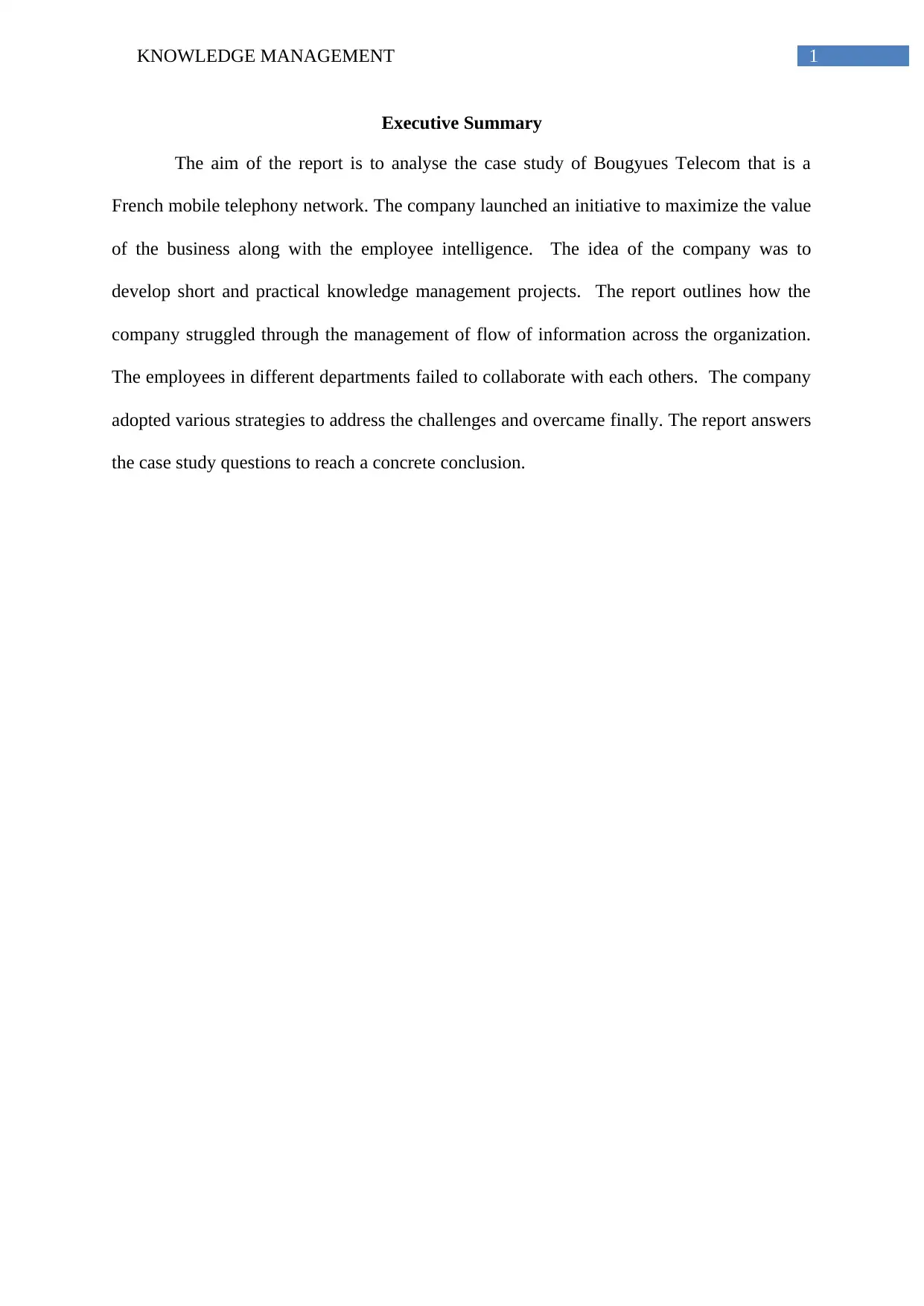
1KNOWLEDGE MANAGEMENT
Executive Summary
The aim of the report is to analyse the case study of Bougyues Telecom that is a
French mobile telephony network. The company launched an initiative to maximize the value
of the business along with the employee intelligence. The idea of the company was to
develop short and practical knowledge management projects. The report outlines how the
company struggled through the management of flow of information across the organization.
The employees in different departments failed to collaborate with each others. The company
adopted various strategies to address the challenges and overcame finally. The report answers
the case study questions to reach a concrete conclusion.
Executive Summary
The aim of the report is to analyse the case study of Bougyues Telecom that is a
French mobile telephony network. The company launched an initiative to maximize the value
of the business along with the employee intelligence. The idea of the company was to
develop short and practical knowledge management projects. The report outlines how the
company struggled through the management of flow of information across the organization.
The employees in different departments failed to collaborate with each others. The company
adopted various strategies to address the challenges and overcame finally. The report answers
the case study questions to reach a concrete conclusion.
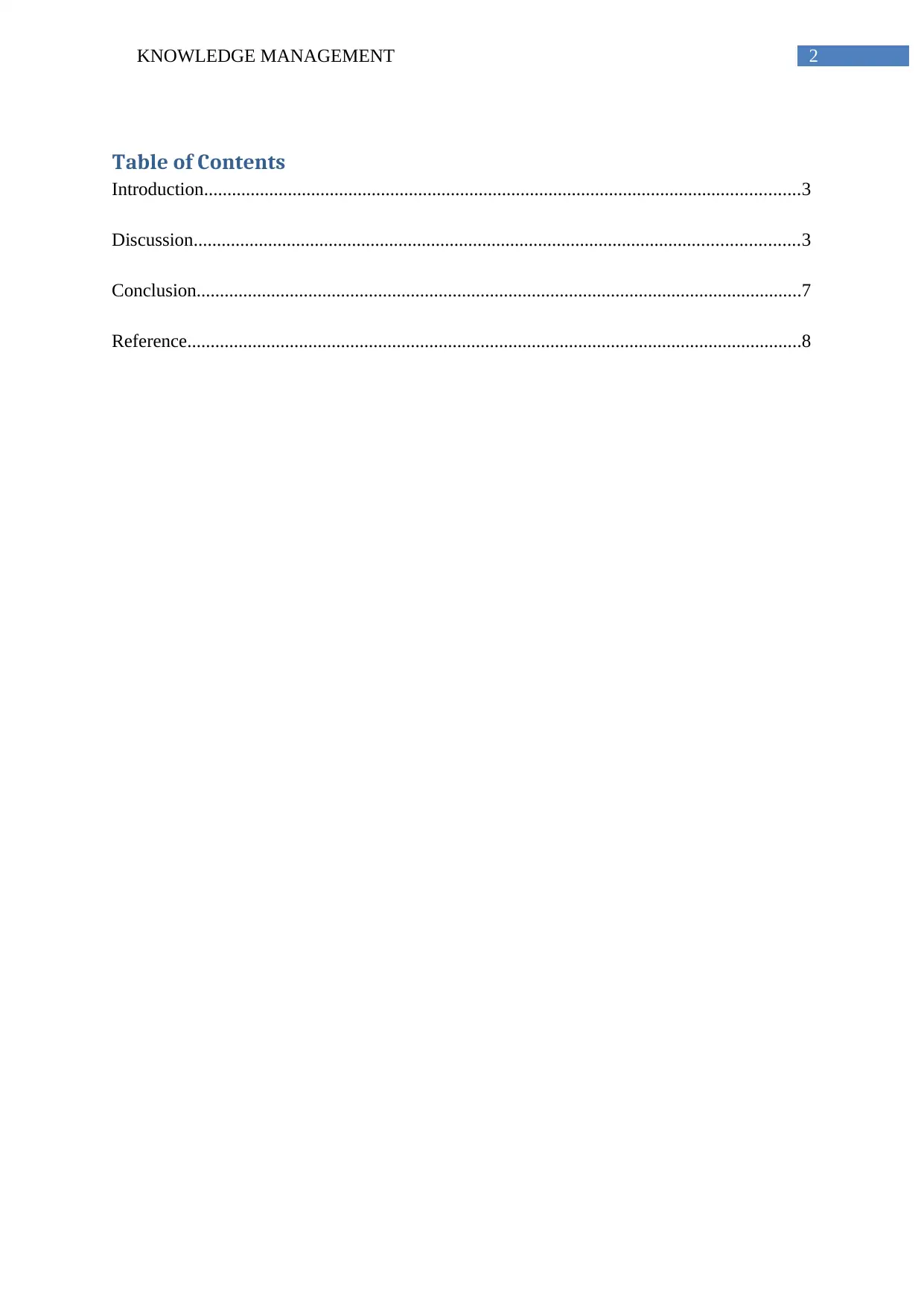
2KNOWLEDGE MANAGEMENT
Table of Contents
Introduction................................................................................................................................3
Discussion..................................................................................................................................3
Conclusion..................................................................................................................................7
Reference....................................................................................................................................8
Table of Contents
Introduction................................................................................................................................3
Discussion..................................................................................................................................3
Conclusion..................................................................................................................................7
Reference....................................................................................................................................8
⊘ This is a preview!⊘
Do you want full access?
Subscribe today to unlock all pages.

Trusted by 1+ million students worldwide
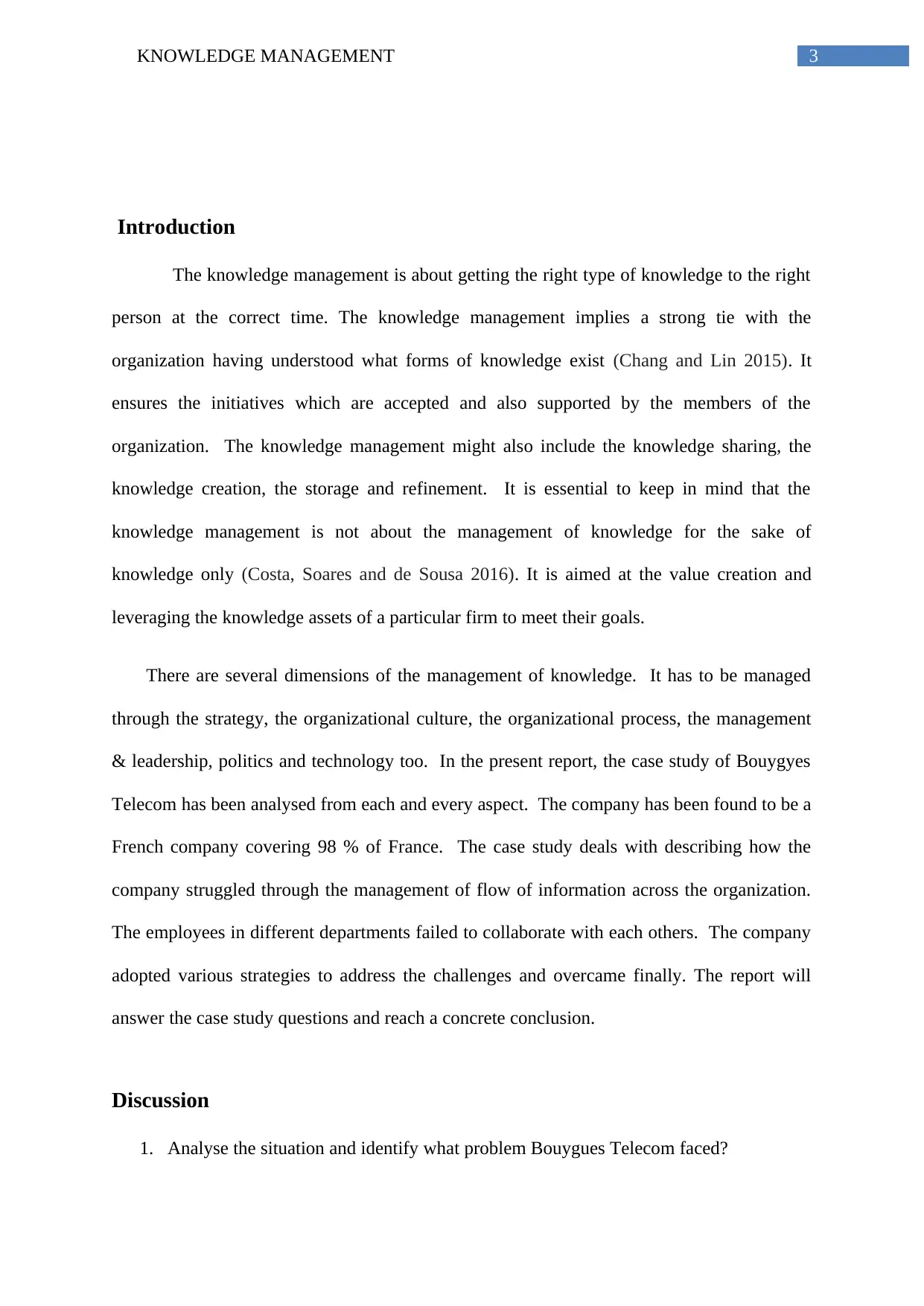
3KNOWLEDGE MANAGEMENT
Introduction
The knowledge management is about getting the right type of knowledge to the right
person at the correct time. The knowledge management implies a strong tie with the
organization having understood what forms of knowledge exist (Chang and Lin 2015). It
ensures the initiatives which are accepted and also supported by the members of the
organization. The knowledge management might also include the knowledge sharing, the
knowledge creation, the storage and refinement. It is essential to keep in mind that the
knowledge management is not about the management of knowledge for the sake of
knowledge only (Costa, Soares and de Sousa 2016). It is aimed at the value creation and
leveraging the knowledge assets of a particular firm to meet their goals.
There are several dimensions of the management of knowledge. It has to be managed
through the strategy, the organizational culture, the organizational process, the management
& leadership, politics and technology too. In the present report, the case study of Bouygyes
Telecom has been analysed from each and every aspect. The company has been found to be a
French company covering 98 % of France. The case study deals with describing how the
company struggled through the management of flow of information across the organization.
The employees in different departments failed to collaborate with each others. The company
adopted various strategies to address the challenges and overcame finally. The report will
answer the case study questions and reach a concrete conclusion.
Discussion
1. Analyse the situation and identify what problem Bouygues Telecom faced?
Introduction
The knowledge management is about getting the right type of knowledge to the right
person at the correct time. The knowledge management implies a strong tie with the
organization having understood what forms of knowledge exist (Chang and Lin 2015). It
ensures the initiatives which are accepted and also supported by the members of the
organization. The knowledge management might also include the knowledge sharing, the
knowledge creation, the storage and refinement. It is essential to keep in mind that the
knowledge management is not about the management of knowledge for the sake of
knowledge only (Costa, Soares and de Sousa 2016). It is aimed at the value creation and
leveraging the knowledge assets of a particular firm to meet their goals.
There are several dimensions of the management of knowledge. It has to be managed
through the strategy, the organizational culture, the organizational process, the management
& leadership, politics and technology too. In the present report, the case study of Bouygyes
Telecom has been analysed from each and every aspect. The company has been found to be a
French company covering 98 % of France. The case study deals with describing how the
company struggled through the management of flow of information across the organization.
The employees in different departments failed to collaborate with each others. The company
adopted various strategies to address the challenges and overcame finally. The report will
answer the case study questions and reach a concrete conclusion.
Discussion
1. Analyse the situation and identify what problem Bouygues Telecom faced?
Paraphrase This Document
Need a fresh take? Get an instant paraphrase of this document with our AI Paraphraser
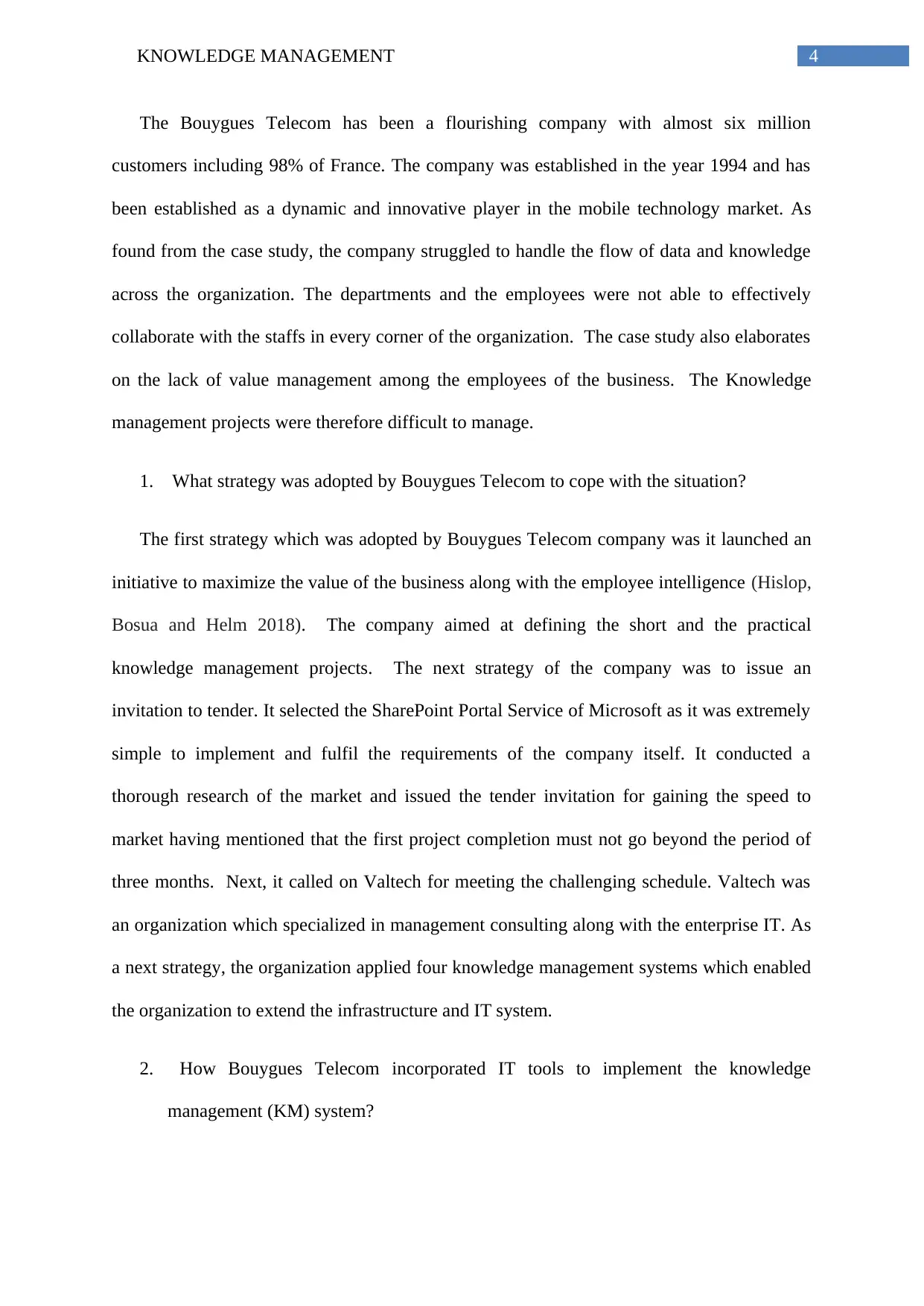
4KNOWLEDGE MANAGEMENT
The Bouygues Telecom has been a flourishing company with almost six million
customers including 98% of France. The company was established in the year 1994 and has
been established as a dynamic and innovative player in the mobile technology market. As
found from the case study, the company struggled to handle the flow of data and knowledge
across the organization. The departments and the employees were not able to effectively
collaborate with the staffs in every corner of the organization. The case study also elaborates
on the lack of value management among the employees of the business. The Knowledge
management projects were therefore difficult to manage.
1. What strategy was adopted by Bouygues Telecom to cope with the situation?
The first strategy which was adopted by Bouygues Telecom company was it launched an
initiative to maximize the value of the business along with the employee intelligence (Hislop,
Bosua and Helm 2018). The company aimed at defining the short and the practical
knowledge management projects. The next strategy of the company was to issue an
invitation to tender. It selected the SharePoint Portal Service of Microsoft as it was extremely
simple to implement and fulfil the requirements of the company itself. It conducted a
thorough research of the market and issued the tender invitation for gaining the speed to
market having mentioned that the first project completion must not go beyond the period of
three months. Next, it called on Valtech for meeting the challenging schedule. Valtech was
an organization which specialized in management consulting along with the enterprise IT. As
a next strategy, the organization applied four knowledge management systems which enabled
the organization to extend the infrastructure and IT system.
2. How Bouygues Telecom incorporated IT tools to implement the knowledge
management (KM) system?
The Bouygues Telecom has been a flourishing company with almost six million
customers including 98% of France. The company was established in the year 1994 and has
been established as a dynamic and innovative player in the mobile technology market. As
found from the case study, the company struggled to handle the flow of data and knowledge
across the organization. The departments and the employees were not able to effectively
collaborate with the staffs in every corner of the organization. The case study also elaborates
on the lack of value management among the employees of the business. The Knowledge
management projects were therefore difficult to manage.
1. What strategy was adopted by Bouygues Telecom to cope with the situation?
The first strategy which was adopted by Bouygues Telecom company was it launched an
initiative to maximize the value of the business along with the employee intelligence (Hislop,
Bosua and Helm 2018). The company aimed at defining the short and the practical
knowledge management projects. The next strategy of the company was to issue an
invitation to tender. It selected the SharePoint Portal Service of Microsoft as it was extremely
simple to implement and fulfil the requirements of the company itself. It conducted a
thorough research of the market and issued the tender invitation for gaining the speed to
market having mentioned that the first project completion must not go beyond the period of
three months. Next, it called on Valtech for meeting the challenging schedule. Valtech was
an organization which specialized in management consulting along with the enterprise IT. As
a next strategy, the organization applied four knowledge management systems which enabled
the organization to extend the infrastructure and IT system.
2. How Bouygues Telecom incorporated IT tools to implement the knowledge
management (KM) system?
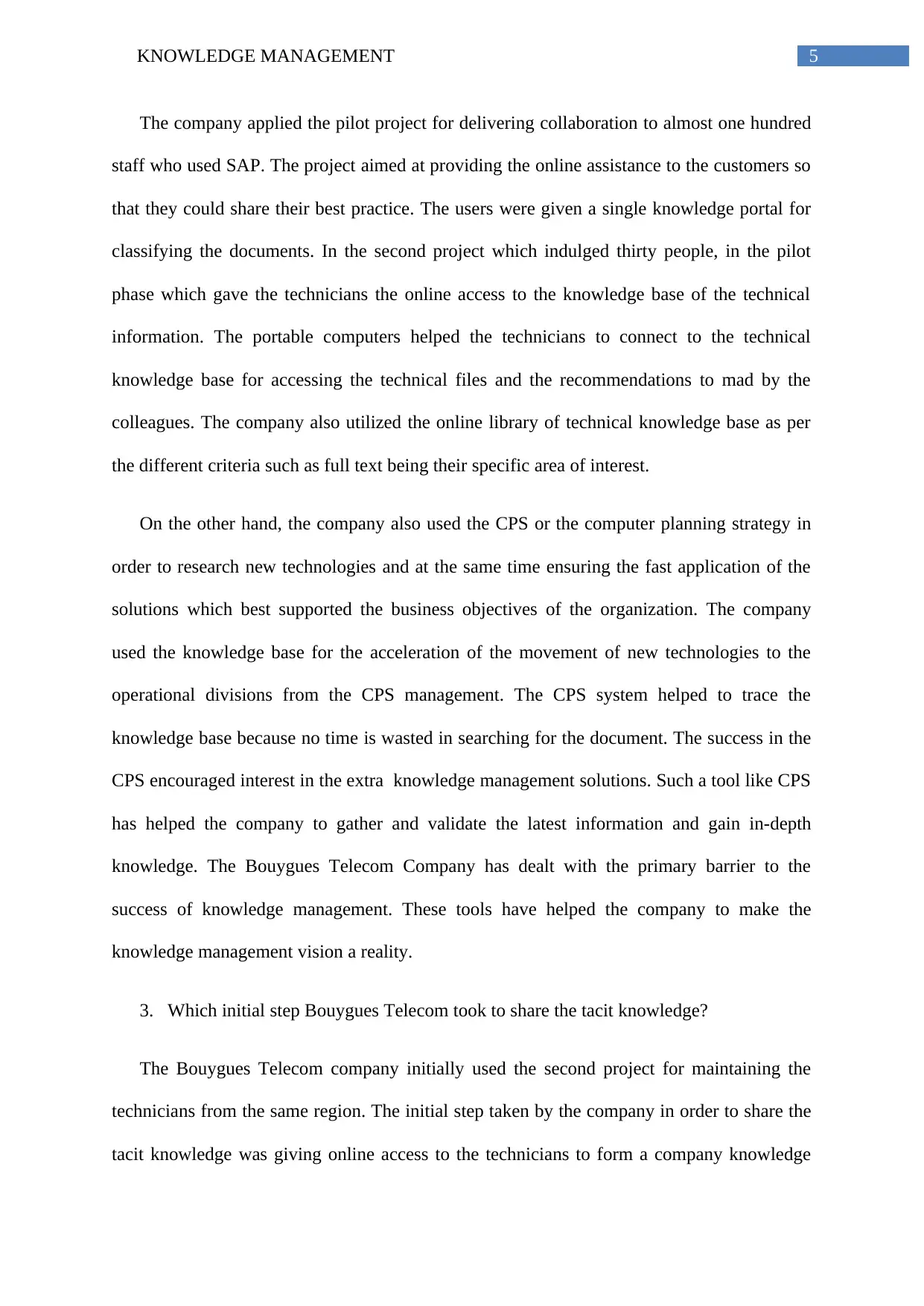
5KNOWLEDGE MANAGEMENT
The company applied the pilot project for delivering collaboration to almost one hundred
staff who used SAP. The project aimed at providing the online assistance to the customers so
that they could share their best practice. The users were given a single knowledge portal for
classifying the documents. In the second project which indulged thirty people, in the pilot
phase which gave the technicians the online access to the knowledge base of the technical
information. The portable computers helped the technicians to connect to the technical
knowledge base for accessing the technical files and the recommendations to mad by the
colleagues. The company also utilized the online library of technical knowledge base as per
the different criteria such as full text being their specific area of interest.
On the other hand, the company also used the CPS or the computer planning strategy in
order to research new technologies and at the same time ensuring the fast application of the
solutions which best supported the business objectives of the organization. The company
used the knowledge base for the acceleration of the movement of new technologies to the
operational divisions from the CPS management. The CPS system helped to trace the
knowledge base because no time is wasted in searching for the document. The success in the
CPS encouraged interest in the extra knowledge management solutions. Such a tool like CPS
has helped the company to gather and validate the latest information and gain in-depth
knowledge. The Bouygues Telecom Company has dealt with the primary barrier to the
success of knowledge management. These tools have helped the company to make the
knowledge management vision a reality.
3. Which initial step Bouygues Telecom took to share the tacit knowledge?
The Bouygues Telecom company initially used the second project for maintaining the
technicians from the same region. The initial step taken by the company in order to share the
tacit knowledge was giving online access to the technicians to form a company knowledge
The company applied the pilot project for delivering collaboration to almost one hundred
staff who used SAP. The project aimed at providing the online assistance to the customers so
that they could share their best practice. The users were given a single knowledge portal for
classifying the documents. In the second project which indulged thirty people, in the pilot
phase which gave the technicians the online access to the knowledge base of the technical
information. The portable computers helped the technicians to connect to the technical
knowledge base for accessing the technical files and the recommendations to mad by the
colleagues. The company also utilized the online library of technical knowledge base as per
the different criteria such as full text being their specific area of interest.
On the other hand, the company also used the CPS or the computer planning strategy in
order to research new technologies and at the same time ensuring the fast application of the
solutions which best supported the business objectives of the organization. The company
used the knowledge base for the acceleration of the movement of new technologies to the
operational divisions from the CPS management. The CPS system helped to trace the
knowledge base because no time is wasted in searching for the document. The success in the
CPS encouraged interest in the extra knowledge management solutions. Such a tool like CPS
has helped the company to gather and validate the latest information and gain in-depth
knowledge. The Bouygues Telecom Company has dealt with the primary barrier to the
success of knowledge management. These tools have helped the company to make the
knowledge management vision a reality.
3. Which initial step Bouygues Telecom took to share the tacit knowledge?
The Bouygues Telecom company initially used the second project for maintaining the
technicians from the same region. The initial step taken by the company in order to share the
tacit knowledge was giving online access to the technicians to form a company knowledge
⊘ This is a preview!⊘
Do you want full access?
Subscribe today to unlock all pages.

Trusted by 1+ million students worldwide
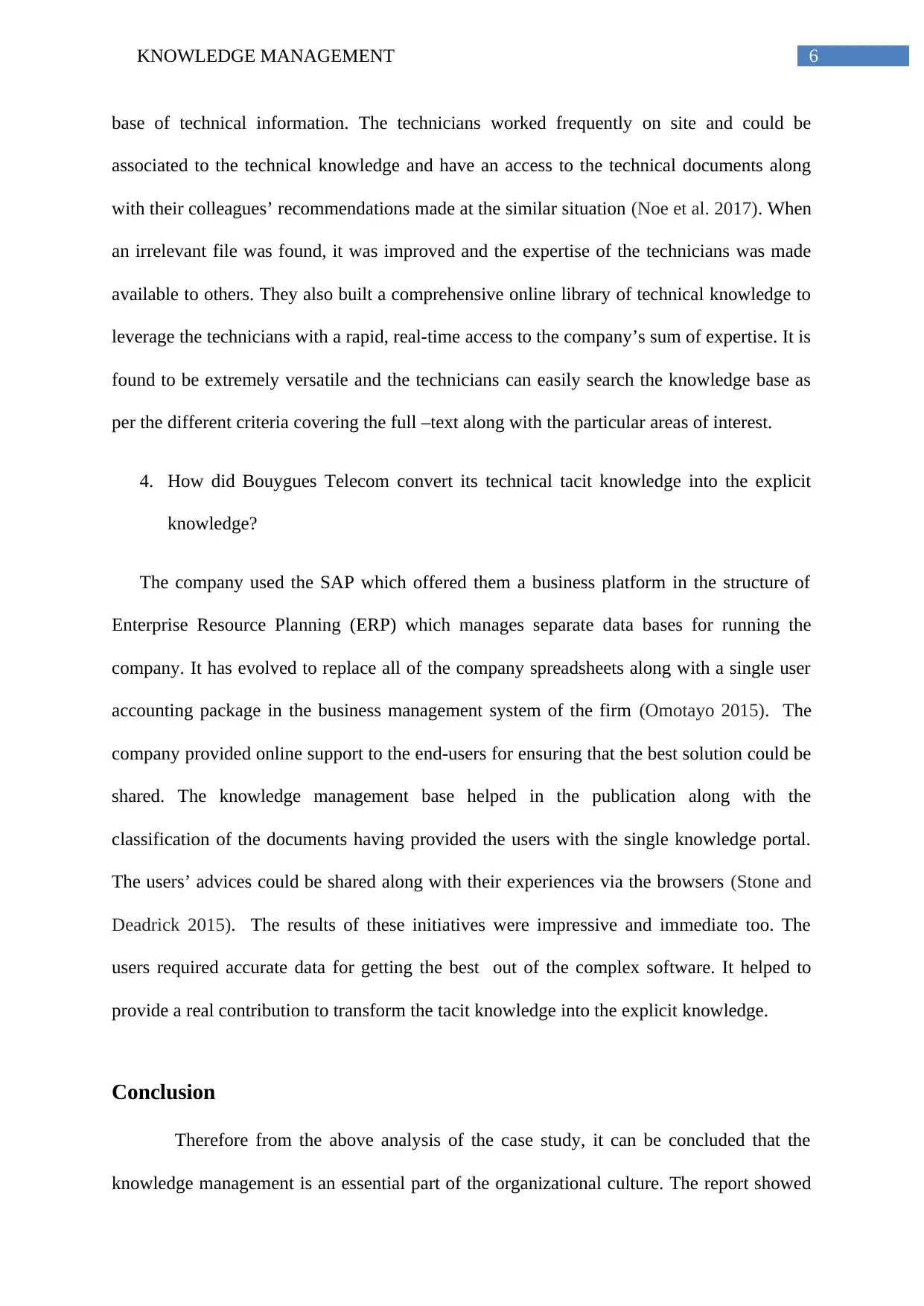
6KNOWLEDGE MANAGEMENT
base of technical information. The technicians worked frequently on site and could be
associated to the technical knowledge and have an access to the technical documents along
with their colleagues’ recommendations made at the similar situation (Noe et al. 2017). When
an irrelevant file was found, it was improved and the expertise of the technicians was made
available to others. They also built a comprehensive online library of technical knowledge to
leverage the technicians with a rapid, real-time access to the company’s sum of expertise. It is
found to be extremely versatile and the technicians can easily search the knowledge base as
per the different criteria covering the full –text along with the particular areas of interest.
4. How did Bouygues Telecom convert its technical tacit knowledge into the explicit
knowledge?
The company used the SAP which offered them a business platform in the structure of
Enterprise Resource Planning (ERP) which manages separate data bases for running the
company. It has evolved to replace all of the company spreadsheets along with a single user
accounting package in the business management system of the firm (Omotayo 2015). The
company provided online support to the end-users for ensuring that the best solution could be
shared. The knowledge management base helped in the publication along with the
classification of the documents having provided the users with the single knowledge portal.
The users’ advices could be shared along with their experiences via the browsers (Stone and
Deadrick 2015). The results of these initiatives were impressive and immediate too. The
users required accurate data for getting the best out of the complex software. It helped to
provide a real contribution to transform the tacit knowledge into the explicit knowledge.
Conclusion
Therefore from the above analysis of the case study, it can be concluded that the
knowledge management is an essential part of the organizational culture. The report showed
base of technical information. The technicians worked frequently on site and could be
associated to the technical knowledge and have an access to the technical documents along
with their colleagues’ recommendations made at the similar situation (Noe et al. 2017). When
an irrelevant file was found, it was improved and the expertise of the technicians was made
available to others. They also built a comprehensive online library of technical knowledge to
leverage the technicians with a rapid, real-time access to the company’s sum of expertise. It is
found to be extremely versatile and the technicians can easily search the knowledge base as
per the different criteria covering the full –text along with the particular areas of interest.
4. How did Bouygues Telecom convert its technical tacit knowledge into the explicit
knowledge?
The company used the SAP which offered them a business platform in the structure of
Enterprise Resource Planning (ERP) which manages separate data bases for running the
company. It has evolved to replace all of the company spreadsheets along with a single user
accounting package in the business management system of the firm (Omotayo 2015). The
company provided online support to the end-users for ensuring that the best solution could be
shared. The knowledge management base helped in the publication along with the
classification of the documents having provided the users with the single knowledge portal.
The users’ advices could be shared along with their experiences via the browsers (Stone and
Deadrick 2015). The results of these initiatives were impressive and immediate too. The
users required accurate data for getting the best out of the complex software. It helped to
provide a real contribution to transform the tacit knowledge into the explicit knowledge.
Conclusion
Therefore from the above analysis of the case study, it can be concluded that the
knowledge management is an essential part of the organizational culture. The report showed
Paraphrase This Document
Need a fresh take? Get an instant paraphrase of this document with our AI Paraphraser
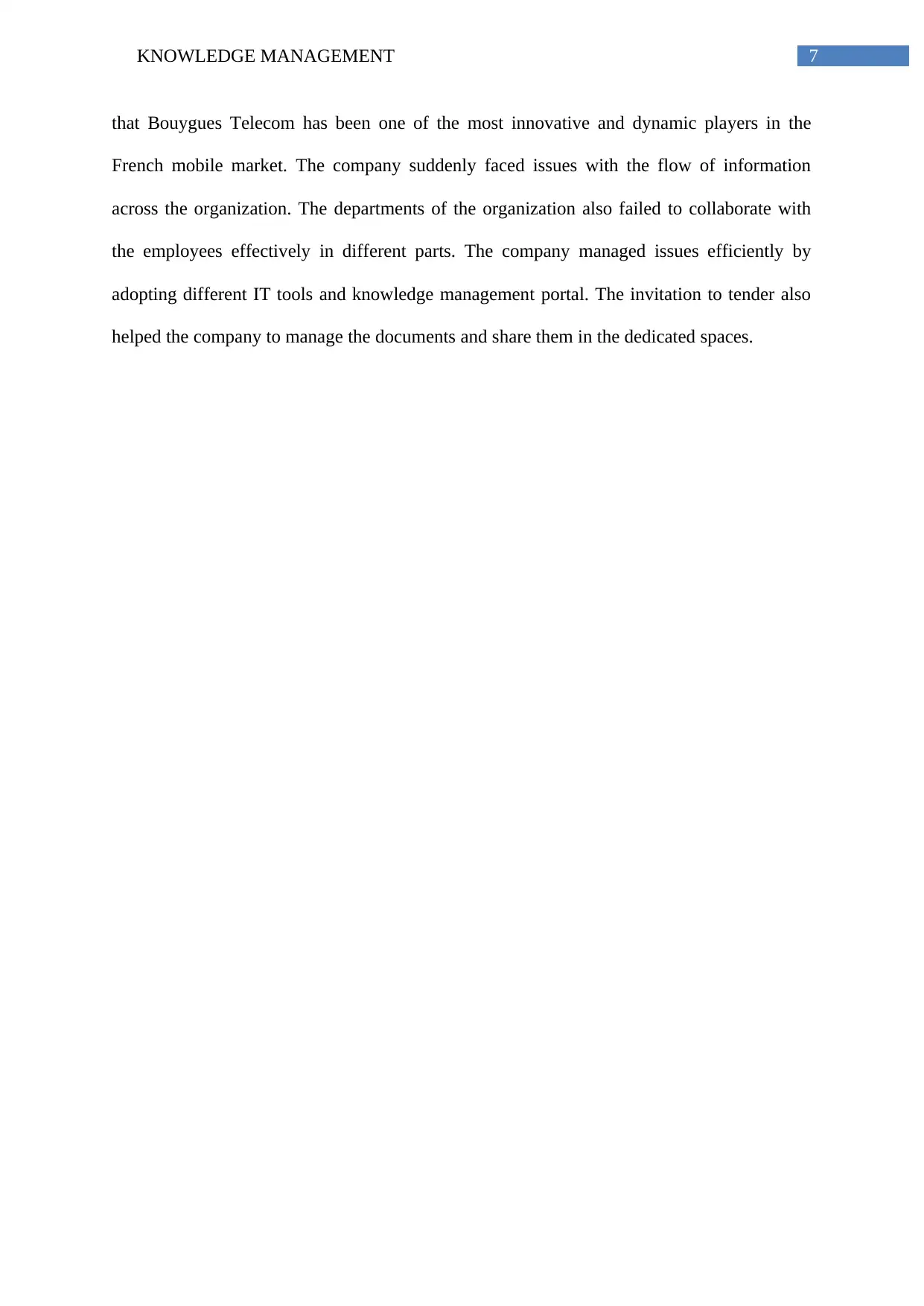
7KNOWLEDGE MANAGEMENT
that Bouygues Telecom has been one of the most innovative and dynamic players in the
French mobile market. The company suddenly faced issues with the flow of information
across the organization. The departments of the organization also failed to collaborate with
the employees effectively in different parts. The company managed issues efficiently by
adopting different IT tools and knowledge management portal. The invitation to tender also
helped the company to manage the documents and share them in the dedicated spaces.
that Bouygues Telecom has been one of the most innovative and dynamic players in the
French mobile market. The company suddenly faced issues with the flow of information
across the organization. The departments of the organization also failed to collaborate with
the employees effectively in different parts. The company managed issues efficiently by
adopting different IT tools and knowledge management portal. The invitation to tender also
helped the company to manage the documents and share them in the dedicated spaces.
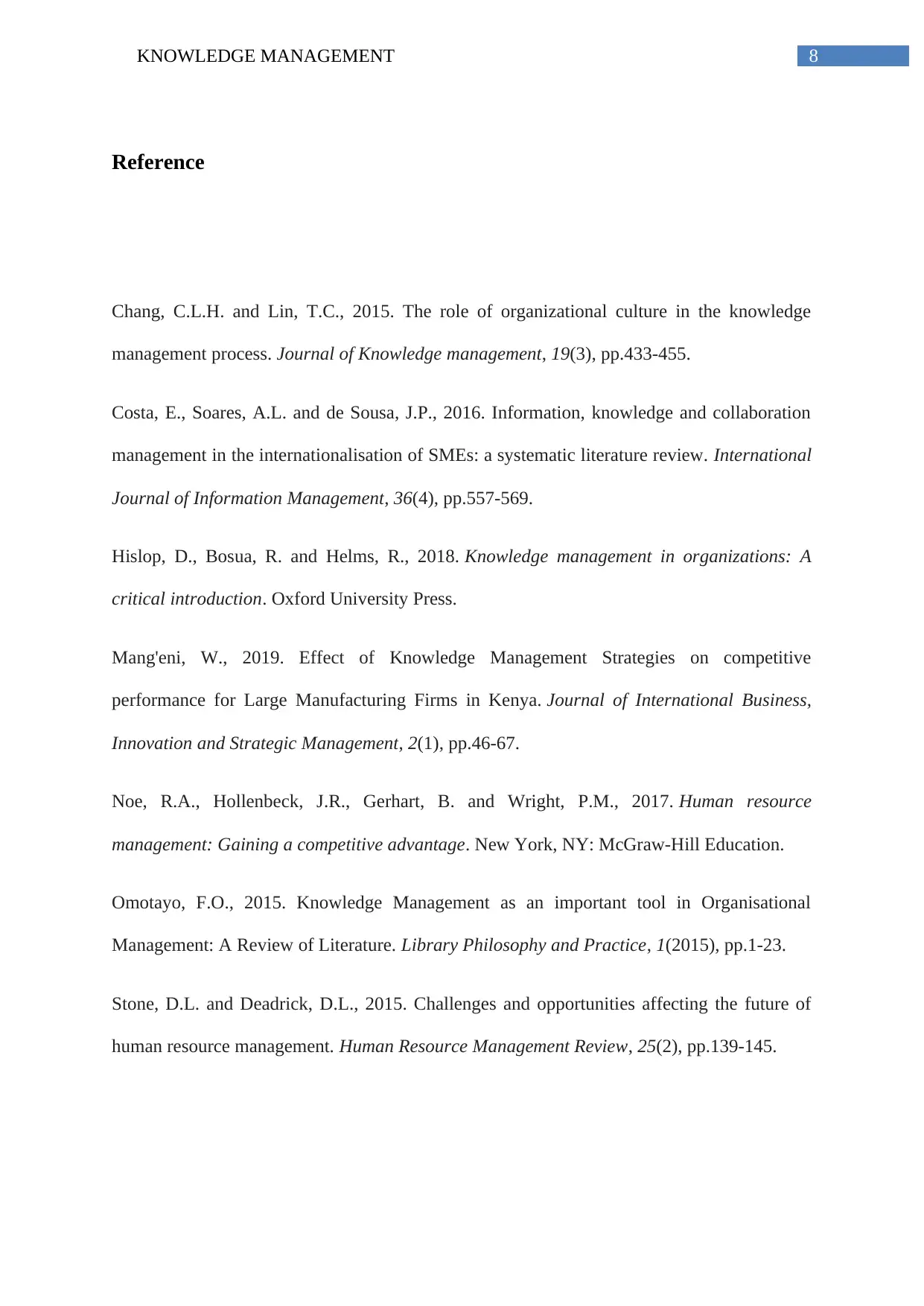
8KNOWLEDGE MANAGEMENT
Reference
Chang, C.L.H. and Lin, T.C., 2015. The role of organizational culture in the knowledge
management process. Journal of Knowledge management, 19(3), pp.433-455.
Costa, E., Soares, A.L. and de Sousa, J.P., 2016. Information, knowledge and collaboration
management in the internationalisation of SMEs: a systematic literature review. International
Journal of Information Management, 36(4), pp.557-569.
Hislop, D., Bosua, R. and Helms, R., 2018. Knowledge management in organizations: A
critical introduction. Oxford University Press.
Mang'eni, W., 2019. Effect of Knowledge Management Strategies on competitive
performance for Large Manufacturing Firms in Kenya. Journal of International Business,
Innovation and Strategic Management, 2(1), pp.46-67.
Noe, R.A., Hollenbeck, J.R., Gerhart, B. and Wright, P.M., 2017. Human resource
management: Gaining a competitive advantage. New York, NY: McGraw-Hill Education.
Omotayo, F.O., 2015. Knowledge Management as an important tool in Organisational
Management: A Review of Literature. Library Philosophy and Practice, 1(2015), pp.1-23.
Stone, D.L. and Deadrick, D.L., 2015. Challenges and opportunities affecting the future of
human resource management. Human Resource Management Review, 25(2), pp.139-145.
Reference
Chang, C.L.H. and Lin, T.C., 2015. The role of organizational culture in the knowledge
management process. Journal of Knowledge management, 19(3), pp.433-455.
Costa, E., Soares, A.L. and de Sousa, J.P., 2016. Information, knowledge and collaboration
management in the internationalisation of SMEs: a systematic literature review. International
Journal of Information Management, 36(4), pp.557-569.
Hislop, D., Bosua, R. and Helms, R., 2018. Knowledge management in organizations: A
critical introduction. Oxford University Press.
Mang'eni, W., 2019. Effect of Knowledge Management Strategies on competitive
performance for Large Manufacturing Firms in Kenya. Journal of International Business,
Innovation and Strategic Management, 2(1), pp.46-67.
Noe, R.A., Hollenbeck, J.R., Gerhart, B. and Wright, P.M., 2017. Human resource
management: Gaining a competitive advantage. New York, NY: McGraw-Hill Education.
Omotayo, F.O., 2015. Knowledge Management as an important tool in Organisational
Management: A Review of Literature. Library Philosophy and Practice, 1(2015), pp.1-23.
Stone, D.L. and Deadrick, D.L., 2015. Challenges and opportunities affecting the future of
human resource management. Human Resource Management Review, 25(2), pp.139-145.
⊘ This is a preview!⊘
Do you want full access?
Subscribe today to unlock all pages.

Trusted by 1+ million students worldwide
1 out of 9
Related Documents
Your All-in-One AI-Powered Toolkit for Academic Success.
+13062052269
info@desklib.com
Available 24*7 on WhatsApp / Email
![[object Object]](/_next/static/media/star-bottom.7253800d.svg)
Unlock your academic potential
Copyright © 2020–2025 A2Z Services. All Rights Reserved. Developed and managed by ZUCOL.




